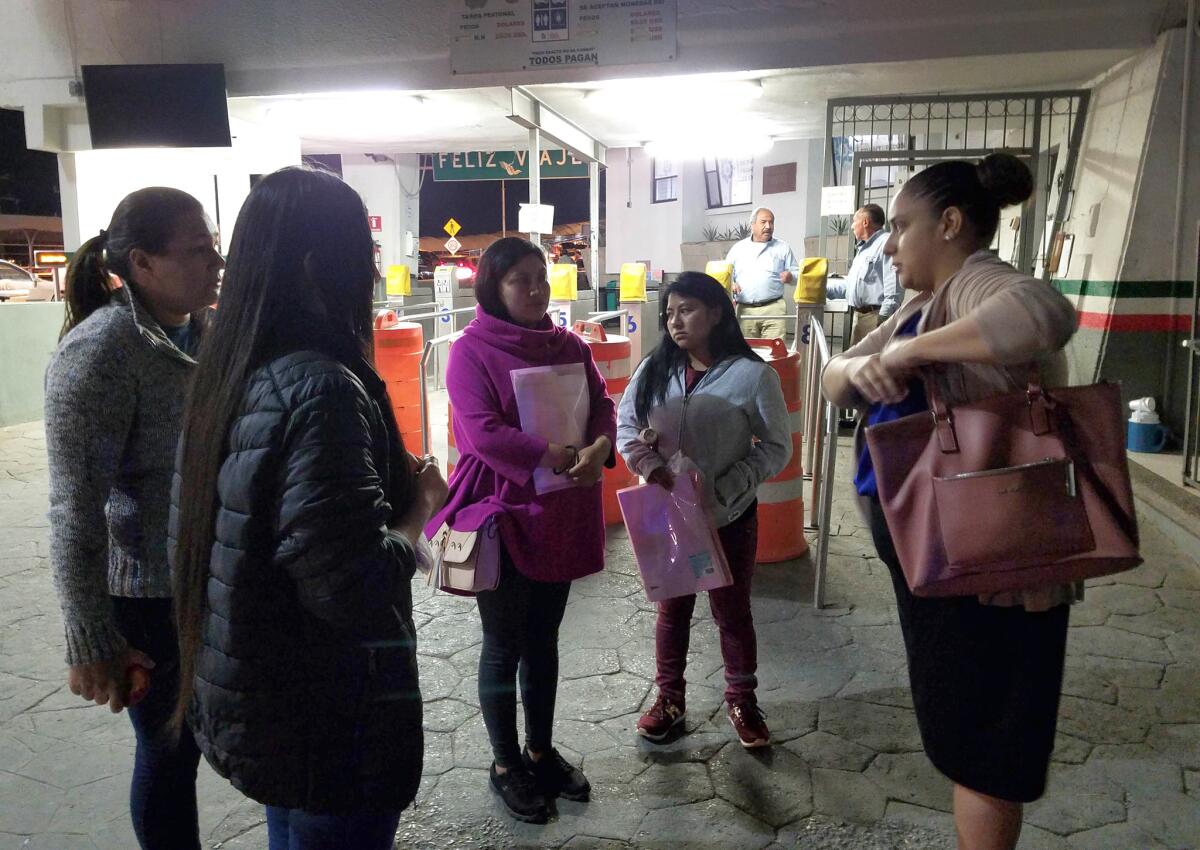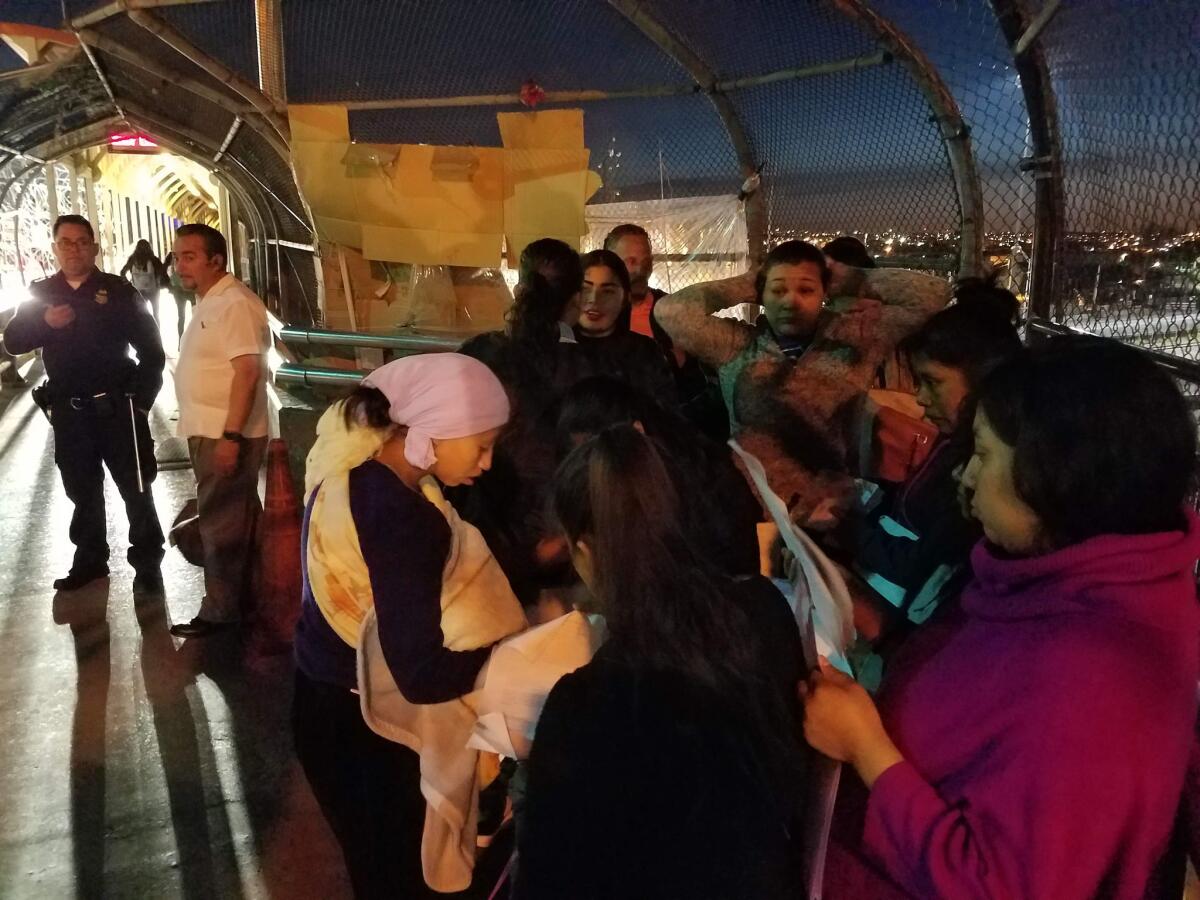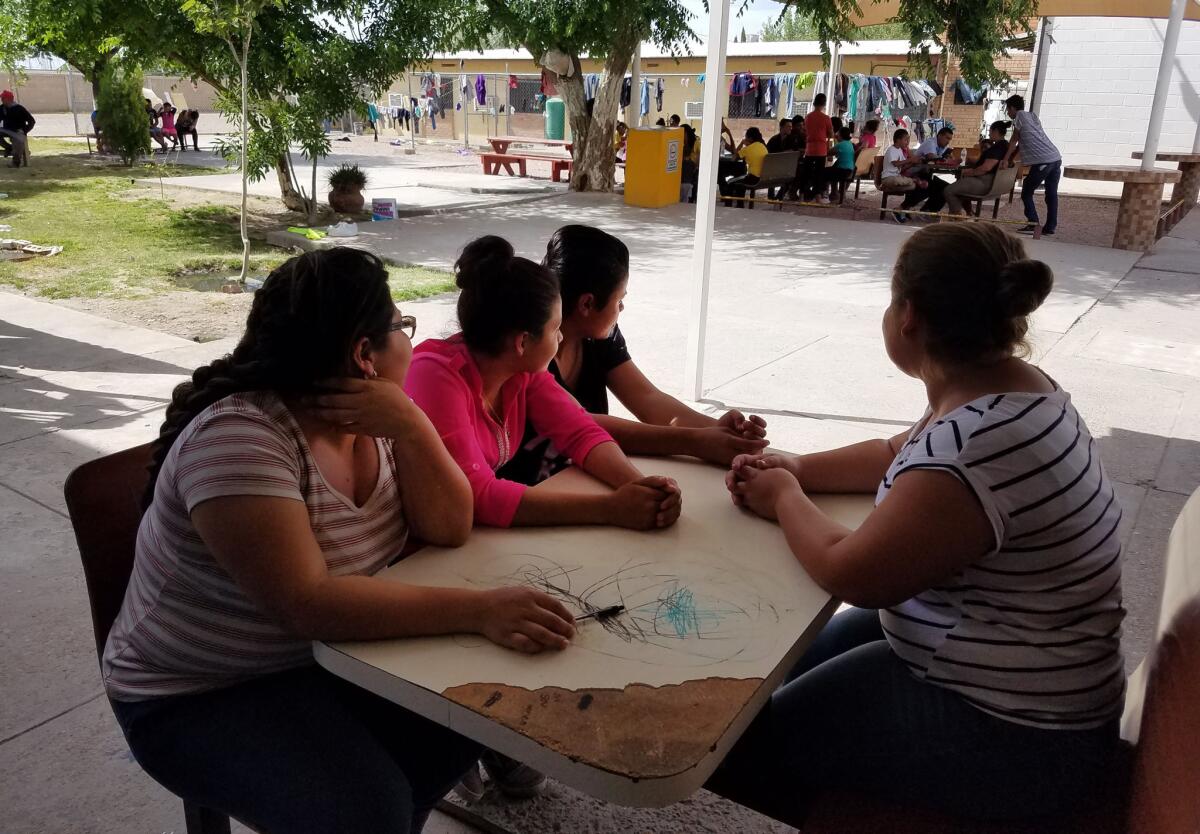Pregnant women, other vulnerable asylum seekers are returned to Mexico to await hearings

Reporting from Ciudad Juarez, Mexico — When Enma Hernandez crossed the Rio Grande here illegally about two weeks ago and approached Border Patrol agents seeking asylum, she told them she was eight months pregnant.
Hernandez, 26, said she had fled Guatemala hoping to join her husband and 2-year-old daughter in Miami. Instead, U.S. immigration officials returned her to Ciudad Juarez under the Trump administration’s “Remain in Mexico” policy.
Rather than being released in the U.S. pending an immigration court hearing, Hernandez would have to wait in Mexico as her case progressed. She can enter the U.S under guard only for court hearings and then return to Mexico until her case is decided.
The program, officially dubbed “Migrant Protection Protocols,” debuted in San Ysidro in January and expanded to El Paso in March, one of several White House initiatives designed to deter asylum seekers who fear persecution at home. The Trump administration has also initiated wait lists at border crossings that have left thousands of migrants waiting in Mexican border shelters for the chance to enter the U.S. to apply for asylum.
Immigrant advocates point out that pregnant women are given priority on the wait lists coordinated by U.S. Customs officers, whereas Border Patrol agents — part of the same agency — include pregnant women in the Remain in Mexico program, placing vulnerable asylum seekers’ lives at risk by forcing them to wait indefinitely in Mexican border cities. Last week, some asylum seekers were returned to Mexico with court dates months away, some in January, because of a growing backlog in U.S. immigration courts of more than 800,000 pending cases.
As of Friday, the U.S. had sent 6,004 asylum seekers back to Mexico under the program, and during the last month, authorities sent 1,713 to Tijuana, 933 to Mexicali and 2,035 to Juarez, according to Mexico’s immigration agency, the National Institute of Migration.
This month, Rep. Veronica Escobar (D-Texas) proposed legislation, co-sponsored by 21 other Democrats, to defund the program. In addition, civil liberties groups have mounted a legal challenge, but the U.S. 9th Circuit Court of Appeals on May 7 allowed the returns to continue while the case is pending.
Homeland Security guidelines exempt unaccompanied children seeking asylum from being returned to wait in Mexico. Others with “known physical/mental health issues” and “individuals from vulnerable populations” are exempted on a case-by-case basis.
But the guidelines do not make provisions for all pregnant women, new mothers, parents with disabled children or transgender migrants — all of whom have been returned to Juarez in recent weeks.
A spokesman for U.S. Customs and Border Protection, whose agents decide which migrants are placed in the program, referred questions to Homeland Security. A Homeland Security spokeswoman declined to comment.
Only about 20 asylum seekers have been exempted from the program and allowed into El Paso, migrant advocates said. They include several Guatemalan parents who speak indigenous languages and two Central American fathers who said they were kidnapped, beaten and robbed in Juarez.
Pregnant women such as Hernandez, on the other hand, have been shipped back to Mexico without medical care to await their hearings on the American side of the border.
Due to waiting lists, Juarez is already strained by an influx of migrants. Its 10 shelters have housed more than 14,000 since large numbers of Central American families began showing up in October. More recently, large groups of Cuban asylum seekers have aggravated the crowding.
A thousand migrants packed overcrowded Juarez shelters last week, said Martha Esquivel de Guerrero, director of Buen Pastor church shelter. Her 10-bed shelter was housing 125 migrants, 35 of them asylum seekers sent back by U.S. immigration officials to Mexico. Most had no choice but to sleep on the floor or between pews. The city’s largest shelter, the 250-bed Casa del Migrante, housed 480 migrants, about 60% of them returnees.
Trump has claimed that asylum seekers are engaging in a “hoax” or “big, fat con job” and that there is an emergency at the border. According to government statistics, nearly 110,000 migrants presented themselves legally at ports of entry or crossed the border illegally last month. That’s the highest monthly total since 2007.
Advocates for greater limits on immigration have also long complained that pregnant migrants come to the U.S. to have “anchor babies” who automatically are citizens. But immigration advocates say that gang violence and political strife in Central America are largely responsible for the influx of asylum seekers and that by law, those fleeing persecution abroad have the right to seek asylum in the United States.
As Hernandez prepared to cross the border bridge from Juarez to El Paso on Thursday to attend her U.S. immigration court hearing, she said she had been too nervous to stay at one of the crowded shelters. Unable to get a Mexican work permit because of her pending U.S. asylum case, she has started working off the books as a cook and has rented an apartment with several other asylum seekers.
She said she fears for her safety. Homicides in Juarez increased in recent years, reaching a 10-year high, and immigrants are easy targets. This month, three Honduran migrants were fatally shot when gunmen stormed a Juarez home.
Hernandez says American officials should let pregnant women remain in the U.S. until their asylum cases are decided.
“We should be an exception because we are vulnerable,” she said. “It’s dangerous for us here.”

Four other pregnant migrants crossed the bridge on Thursday with her, along with a new mother carrying her 6-day-old daughter. All were in the Remain in Mexico program.
Linda Rivas, executive director of El Paso-based Las Americas Immigrant Advocacy Center, represents the mother and accompanied the group across the bridge. She and other advocates had alerted the Border Patrol about the women and requested they be allowed to stay in the United States.
Rivas represents other Central American asylum seekers, including a transgender migrant and a man with a disabled son, who were initially returned to Mexico but later allowed to stay in the U.S. while their immigration cases are pending.
“It seems arbitrary,” Rivas said of which migrants are exempted.
She accompanied the migrant women across the bridge, but once they reached Border Patrol, they entered U.S. custody and Rivas had to leave, telling them she would see them in court.
They never made it there.
Of 31 migrants scheduled to appear in El Paso immigration court, guards brought nine. All nine said they feared returning to Mexico. One woman said through tears that the pastor she had been staying with in Juarez had been kidnapped. The U.S. immigration judge ordered immigration officials to speak with the asylum applicants before they were sent back to Mexico, and scheduled their next hearings for August.
It wasn’t initially clear what happened to Hernandez and the other women who did not appear. Immigration Judge Nathan Herbert asked Rivas and an attorney representing the government. Neither of them said they knew. The judge asked the government lawyer to find out, but he said after the hearing that he still didn’t know.
Rivas later learned that Border Patrol had the women in custody. She worried they had been placed in chilly holding areas, called hieleras, where migrants sometimes wait for days before being released. Since December, three Central American migrant children have died after falling ill in U.S. custody in the El Paso area.
On Friday afternoon, Rivas was reunited with one of the women, her client, new mother Raquela Pedro Juan, 21. Rivas said Pedro Juan had been held in a hielera overnight with her baby, then released and allowed to stay in the U.S. while her asylum case is pending.
Late Friday, a Homeland Security official released a statement saying seven women had been stopped after crossing the bridge and investigated because some were wearing microphones after talking to reporters.
“The migrants involved were interviewed, as is routine for all [Remain in Mexico] participants, to determine if they continued to meet the requirements” for the program, the official said. “Six of the individuals are scheduled to return to Mexico under the program and one is being processed through other appropriate immigration channels.”

The Remain in Mexico program appears to be deterring some migrants from pursuing their asylum claims.
Some returnees at the Casa del Migrante shelter have left in recent days with people who staffers suspect are smugglers helping them try to cross the border illegally. Others have decided to return to Central America.
Victoria, 28, who asked to be identified only by her first name due to safety concerns, said she fled Honduras after her husband, a rancher, received death threats from a gang. They were separated by Border Patrol agents once they crossed the Rio Grande and she spent two days in the rain in an outdoor holding area.
“Smugglers treat us better. I was told Mexico was dangerous. It’s worse there with Border Patrol. They’re animals,” she said.
Her first court date is Jan. 15, 2020. She didn’t have an attorney or a place to stay and feared, “I’m going to be here years.”
Her father back in Honduras was injured in a truck crash, lost his left foot and is depending on her for support, she said. So she won’t be staying to pursue asylum in the United States.
“I can’t take that chance,” Victoria said as she sat at a table in the shelter’s courtyard, surrounded by a dozen others, including some families with children.
Beside her, Xiomara, 21, said she left her rural hometown in El Salvador last month after a masked man armed with a knife tried to rape her. She fled to join family in Tallahasee, Fla., expecting she would be released to a U.S. shelter, as relatives had been after they crossed to Texas last month. Instead, she was returned to Juarez, also with a Jan. 15 court date. Now she too planned to return home.
“We came at a bad time,” she said.
In Roma, Texas, residents must choose: Help Border Patrol, or border crossers? »
Cecilia Sanchez of The Times’ Mexico City bureau contributed to this report.
More to Read
Sign up for Essential California
The most important California stories and recommendations in your inbox every morning.
You may occasionally receive promotional content from the Los Angeles Times.











